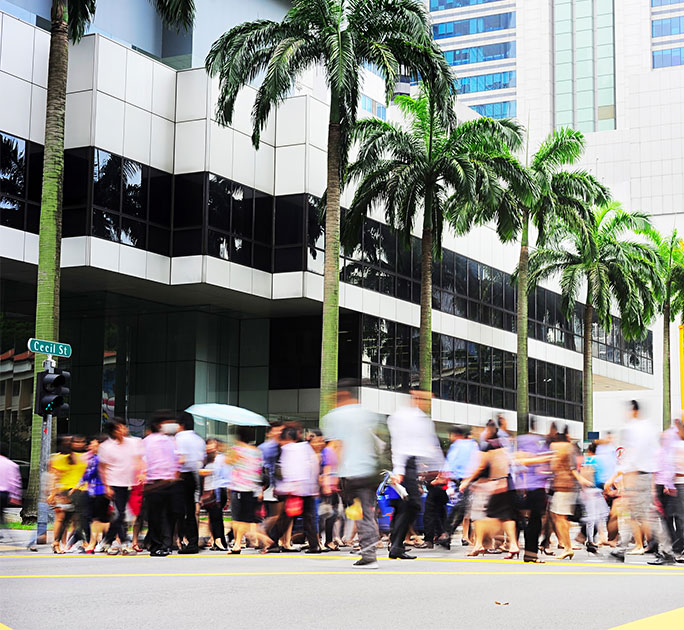Preparing for GST rate changes
![]()
If you’ve only got a minute:
- The government rolled out a S$8 billion Assurance Package (AP) in early 2022 to help cushion the effects of the GST hike and the rising cost of living.
- To prepare for the expected rise in cost of living, start by prioritising your expenditures by differentiating needs from wants and make it a habit to review your expenses monthly or quarterly to make necessary adjustments.
- Review your emergency funds and intended retirement income periodically to better prepare yourself for the long term.
![]()
Since 1 Jan 2023, GST has been increased from 7% to 8%, and will be increased to 9% in 2024. The GST hike serves to support public expenditures in areas like healthcare, education and security. To help Singaporeans cope with the impact of the GST increase, the government rolled out a S$6.6 billion Assurance Package (AP) in early 2022. Another S$1.4 billion was pumped into the AP on 7 November 2022, bringing it to S$8 billion. This initiative helps to cushion the effects of the GST hike and the rising cost of living.
Assurance package (AP) cash

Source: https://www.govbenefits.gov.sg/am-i-eligible/ap-cash/
Every Singaporean aged 21 and above will receive cash benefits of S$700 to S$1,600, depending on his income and property ownership. The payment will be disbursed over 5 years, from 2022 to 2026.
December 2022 cash payout details
Eligible citizens should have already received the first tranche of AP benefits that consist of a one-off cost-of-living (COL) Special Payment of up to S$500, together with AP Cash of up to S$200 that was disbursed in the early weeks of December 2022.
The AP cash is based on your assessable income for year 2022. The one-off COL special payment is disbursed based on an assessable income of not more than S$100,000 in the YA 2022 coupled with not more than one property ownership.

Source: https://www.govbenefits.gov.sg/costofliving-special-payment/
You may login to the e-services to view your eligibility for the AP Cash.
AP Package Medisave
Besides cash payouts, Community Development Council (CDC) vouchers, USave rebates and MediSave top-ups will also be rolled out in the subsequent months and years. These amounts will be disbursed over 5 years from December 2022.
If you are eligible for the AP MediSave, you will receive a total top-up of S$450 from 2023 to 2025 in February each year.

Source: https://www.govbenefits.gov.sg/am-i-eligible/ap-medisave/

Source: https://www.govbenefits.gov.sg/when-will-i-be-paid/ap-medisave/

GSTV – Cash (Seniors’ Bonus)
Lower-income Singaporean seniors will receive additional cash payments of S$600 to S$900 through the GSTV – Cash (Seniors’ Bonus). The payments will be disbursed over 3 years, from 2023 to 2025.
Additional GSTV – U-Save
The additional U-Save rebates will be credited together with the regular U-Save rebates directly into your household’s utility account managed by SP Services to help offset household utility expenses.
Eligible households will be notified through quarterly inserts sent together with their utility bills and receive their quarterly GSTV – U-Save rebates automatically in April, July, October, as well as January 2023

Source: https://www.govbenefits.gov.sg/am-i-eligible/additional-gstv-u-save/
Community Development Council (CDC) vouchers
The 2023 CDC Vouchers will also be disbursed in January 2023.

Source: https://www.govbenefits.gov.sg/am-i-eligible/cdc-vouchers/
The government will partner the CDCs to distribute 2 rounds of S$200 CDC vouchers under the AP to all Singaporean households in 2023 and 2024 (i.e. S$400 in total). Separately, as part of the S$1.5 billion support package announced in Oct 2022 to provide further cost of living relief, every Singaporean household will receive additional S$100 CDC Vouchers in 2023.
The vouchers can be spent at participating heartland merchants and hawkers, and supermarkets.
How does this affect me?
Here are 3 things you need to know about the new GST rates as a consumer.
1. Price displays must show new GST rate
From 1 January 2023, the prices displayed by GST-registered businesses must be inclusive of GST at 8%. That is the final price you pay. Businesses that are unable to switch their price display overnight may display 2 prices:
- One applicable before 1 Jan 2023 showing prices inclusive of GST at 7%
- One applicable on/after 1 Jan 2023 showing prices inclusive of GST at 8%
2. Payment date matters
Purchases of goods and services from GST-registered businesses before 1 Jan 2023 will be subject to GST at 7%, and purchases on/after 1 Jan 2023 will be subject to GST at 8%.
As a consumer, you may order an item or sign up for services but only pay on a later date. The GST charged is determined by the time of payment.
For example, if you purchased a big-ticket item and received an invoice before 1 Jan 2023 but receipt of payment is on 3 Jan 2023, 8% GST will be incurred.
Some other scenarios include:
A. I book a hotel package for my wedding to be held in 2023, on 21 Dec 2022. The price of the package is S$8,000 excluding GST. I pay a deposit of S$1,070 ( S$1,000 + S$70 GST at 7%) on 28 Dec 2022, with the balance to be paid on 5 Mar 2023.

GST is charged at 7% on payment made before 1 Jan 2023 and 8% on payment made after 1 Jan 2023. In this case, 8% GST is chargeable on the remaining unpaid balance of S$7,000 (GST-exclusive). Hence, you will need to pay S$7,560 on 5 Mar 2023 ( S$7,000 + S$560 GST at 8%).
B. I bought a television from Supplier D on 20 Dec 2022. I signed up a 10-month instalment payment plan offered by Supplier D from Dec 2022 to Sep 2023. I made the first payment on 20 Dec 2022. Supplier D delivers the television to me on 3 Jan 2023.

GST is charged at 7% on payment made before 1 Jan 2023. You will pay 7% on the first instalment payment before 1 Jan 2023, and 8% on the subsequent instalment payments on/after 1 Jan 2023. However, if the television is delivered to you before 1 Jan 2023, you will pay 7% GST on all the subsequent instalment payments.
C. I signed up for a 3-year course on 1 Jan 2021, which ends on 31 Dec 2023. The course fees are billed on an annual basis at the start of each calendar year. The invoice for the course fees for Year 2023 is issued to me on 15 Dec 2022, with 7% GST charged.

GST is charged a 7% on payment made before 1 Jan 2023 and at 8% on payment made after 1 Jan 2023. Hence, if you pay Year 2023’s course fees in full before 1 Jan 2023, the applicable GST rate is 7%. However, if you pay Year 2023’s course fees on/after 1 Jan 2023, you will be charged GST at 8%. You should receive a credit note from the course provider to cancel the tax invoice with 7% GST, and a new tax invoice with 8% GST on the unpaid balance.
D. I purchase goods costing over S$400 from a GST-registered overseas Vendor E* on 18 Dec 2022. I make full payment for the goods on 31 Dec 2022. The goods are imported into Singapore on 2 Jan 2023.

GST is charged at 8% on the import of goods over S$400 on/after 1 Jan 2023. Hence, you will pay 8% GST to Singapore Customs for the goods imported after 1 Jan 2023.
*Note: The extension of the Overseas Vendor Registration regime to supplies of low-value goods by GST registered suppliers will take effect from 1 Jan 2023. Low-value goods refer to goods with value not exceeding S$400, and which are located outside Singapore at the point of sale and will not be imported via air or post.
For transactions that span 1 Jan 2023, GST transitional rules may apply. A transaction spans the GST rate change where one or more of the following events takes place wholly or partially on/after 1 Jan 2023:
- The issuance of invoice
- The receipt of payment
- The delivery of goods or performance of services
3. Unjustified price increases using GST as a cover is unethical
It is unacceptable for businesses to use the GST increase as the reason for raising prices before the GST rate change, nor is it acceptable for a business to raise prices by more than the GST increase after the GST rate change, citing the GST increase as the reason.
Simply check if a business is GST-registered by accessing the Register of GST registered businesses.
Do not fall prey to businesses that use GST as an excuse to increase prices.

Prepare for the expected rise in the cost of living
Here are 5 easy ways to start.
1. Shop wisely
Purchase big-ticket items such as furniture, home appliances or car, before the GST hike. For example, if you’re planning on buying home appliances and furniture that would cost you a total of S$50,000, a GST hike of 1% in the next year will cost you S$500 more, and S$1,000 in the following year.
Time and evaluate your purchases as the total savings will be substantial
In the long run, consider buying house brand products at supermarkets, bulk buy non-perishables if there is significant discount, and always be on the lookout for deals and promos to get more bang for your buck.
Read more: Use your credit card to your advantage
2. Track your ongoing expenses
Ongoing expenses such as cable TV, Netflix and Spotify subscriptions or club and gym memberships will indefinitely be affected by the GST hike.
Are these essentials you can’t do without? Consider cancelling them or opt for cheaper alternatives?
Keep track of your usage patterns for these recurring expenses so you can review your real need for these expenditures.
Use the digital financial advisory tool on DBS digibank to help you keep track of your expenses automatically, and set up a budget that includes saving and spending targets.
In today’s environment of rising prices, it is necessary for most of us to tighten our belts and understand our spending habits. Track your expenditure and find out areas you can work on to reduce discretionary spend and enhance your financial situation to manage the uncertainties ahead.
Read more: Track your savings and spending with digibank
3. Review your budget
With GST slated to increase by 2 percentage points within the next 2 years, you know your expenditure is going to rise. To arrive at a better financial position, start assessing your earning capacity and spending now.
For example, do you really need that gym membership to keep fit and healthy? Consider jogging outdoors or following YouTube workouts at home to cut costs.
Factor in the 9% GST into your budget now, so that you will be able to set aside the money required for the projected increase in advance.
Besides trying to increase your income, it helps to be more prudent with how you spend. Start by prioritising your expenditures by differentiating needs from wants. Make it a habit to review your expenses on a monthly or quarterly basis to make necessary adjustments.
Read more: Get more interest out of your idle cash
4. Plan your finances for the long term
The upcoming GST hike will result in a general rise in the cost of living.
Not only does this impact your budget and expenses, it may also derail your long-term financial plans. Having to spend more translates to having less to save and invest.
In the light of the higher cost of living, review your emergency funds and intended retirement income periodically to better prepare yourself for the long term.
Most financial plans assume an inflation rate of 1.5% - 2% when projecting future income flows to determine retirement adequacy. Plan for higher costs of living by assuming different inflation scenarios of 3%, 4% or 5% and work out how these different rates impact your future cash flows and retirement planning.
The Map Your Money feature in DBS digibank allows for different projections of inflation rates and investment yields, which is great for stress-testing your finances and identifying your gaps early for clarity.
Read more: Habits to embrace in your financial journey
Find out more about: Plan with digibank

5. Support small local businesses
Not all businesses will be affected by the projected GST hike, as they only need to be registered for GST when their taxable turnover exceed S$1 million.
Save money on GST by purchasing groceries from small, family-run provision shops in your neighbourhood, instead of a chain supermarket. While saving on GST, you are also helping another local family stay afloat.
Ready to start?
Check out digibank to analyse your real-time financial health. The best part is, it’s fuss-free – we automatically work out your money flows and provide money tips.
Speak to the Wealth Planning Manager today for a financial health check and how you can better plan your finances.
Disclaimers and Important Notice
This article is meant for information only and should not be relied upon as financial advice. Before making any decision to buy, sell or hold any investment or insurance product, you should seek advice from a financial adviser regarding its suitability.








That's great to hear. Anything you'd like to add? (Optional)
We’re sorry to hear that. How can we do better? (Optional)